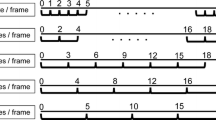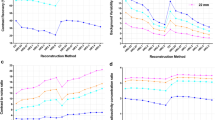Abstract
We evaluate the effects of list-mode reconstruction and the image-space point spread function (iPSF) on the contrast and quantitative values of positron emission tomography (PET) images using a SiPM-PET/CT system. The evaluation is conducted on an NEMA body phantom and clinical images using a Cartesion Prime SiPM-PET/CT system. The signal-to-background ratio (SBR) of the phantom is set to 2, 4, 6, and 8, and all the PET image data are obtained and reconstructed using 3D-OSEM, time-of-flight, iPSF (−/ +), and a 4-mm Gaussian filter with several iterations. The evaluation criteria include % background variability (NB,10 mm), % contrast (QH,10 mm), iPSF change in QH,10 mm (ΔQH,10 mm) for edge artifact evaluation, profile curves, visual evaluation of edge artifacts, clinical imaging for the standardized uptake value (SUV) of lung nodules, and SNRliver. NB,10 mm demonstrates no significant difference in all SBRs with and without iPSF, whereas QH,10 mm is higher based on the SBR with and without iPSF. ΔQH,10 mm indicates increased iterations and a larger rate of change (> 5%) for small spheres of < 17 mm. The profile curves portrayed almost real concentrations, except for the 10-mm sphere of SBR2 without iPSF; however, with iPSF, an overshoot was observed in the 13-mm sphere of all SBRs. The degree of overshoot increased with increasing iteration and SBR. Edge artifacts were detected at values ≥ 17–22 mm in SBRs other than SBR2 with iPSF. Irrespective of the nodal size, SUV and SNRliver improved considerably after iPSF adjustment. Therefore, the effects of list-mode reconstruction and iPSF on PET image contrast were limited, and the overcorrection of the quantitative values was validated using iPSF.














Similar content being viewed by others
References
Lu Z, Lin M, Downe P, et al. The prognostic value of mid- and post-treatment [(18) F] fluorodeoxyglucose (FDG) positron emission tomograp-hy (PET) in indolent follicular lymphoma. Ann Nucl Med. 2014;28(8):805–11.
Pauwels EK, Coumou AW, Kostkiewicz M, et al. [18F]fluoro-2-deoxy-d-glucose positron emission tomography/computed tomography imaging in oncology: initial staging and evaluation of cancer therapy. Med Princ Pract. 2013;22(5):427–37.
Tsutsui Y, Awamoto S, Himuro K, et al. Evaluating and comparing the image quality and quantifcation accuracy of SiPM-PET/CT and PMT-PET/CT. Ann Nucl Med. 2020;34:725–35.
Barrett HH, White T, Parra LC. List-mode likelihood. J Opt Soc Am A Opt Image Sci Vis. 1997;14(11):2914–23.
Tong S, Alessio AM, Kinahan PE. Image reconstruction for PET/CT scanners: past achievements and future challenges. Imaging Med. 2010;2(5):529–45.
Bharkhada D, Panin V, Conti M, et al. Listmode reconstruction for biograph vision PET/CT scanner. In: 2019 IEEE nuclear science symposium and medical imaging conference (NSS/MIC), Manchester; 2019. p. 1–6.
Panin VY, Kehren F, Michel C, et al. Fully 3-D PET reconstruction with system matrix derived from point source measurements. IEEE Trans Med Imaging. 2006;25(7):907–21.
Alessio AM, Kinahan PE, Lewellen TK. Modeling and incorporation of system response functions in 3-D whole body PET. IEEE Trans Med Imag. 2006;25(7):828–37.
Alessio AM, et al. Application and evaluation of a measured spatially variant system model for PET image reconstruction. IEEE Trans Med Imag. 2010;29(3):938–49.
Reader AJ, Julyan PJ, Williams H, et al. EM algorithm system modeling by image-space techniques for PET reconstruction. IEEE Trans Nucl Sci. 2003;50(5):1392–7.
Rahmim A, Qi J, Sossi V. Resolution modeling in PET imaging: theory, practice, benefits, and pitfalls. Med Phys. 2013;40(6): 064301.
Sureau FC, Reader AJ, Comtat C, et al. Impact of image-space resolution modeling for studies with the high-resolution research tomograph. J Nucl Med. 2008;49(6):1000–8.
Rapisarda E, Bettinardi V, Thielemans K, et al. Image-based point spread function implementation in a fully 3D OSEM reconstruction algorithm for PET. Phys Med Biol. 2010;55(14):4131–51.
Bai B, Esser PD. The effect of edge artifacts on quantification of positron emission tomography. In: IEEE Nuclear science symposium and medical imaging conference record; 2010. p. 2263–2266.
Kadrmas DJ, Casey ME, Conti M, et al. Impact of time-of-flight on PET tumor detection. J Nucl Med. 2009;50:1315–23.
Thielemans K, Asma E, Ahn S, et al. Impact of PSF modelling on the convergence rate and edge behaviour of EM images in PET. In: IEEE Nucl Sci Symp Conf Rec; 2010. p. 3267–3272.
Tong S, Alessio AM, Thielemans K, et al. Properties and mitigation of edge artifacts in PSF-based PET reconstruction. IEEE Trans Nucl Sci. 2011;58(5):2264–75.
Watson CC. Estimating effective model kernel widths for PSF reconstruction in PET. In: IEEE Nucl Sci Symp Conf Rec; 2011. p. 2368–2374.
Matheoud R, Ferrando O, Valzano S, et al. Performance comparison of two resolution modeling PET reconstruction algorithms in terms of physical figures of merit used in quantitative imaging. Phys Med. 2015;31(5):468–75.
Alessio AM, Stearns CW, Tong S, et al. Application and evaluation of a measured spatially variant system model for PET image reconstruction. IEEE Trans Med Imaging. 2010;29(3):938–49.
Fukukita H, Suzuki K, Matsumoto K, et al. Japanese guideline for the oncology FDG-PET/CT data acquisition protocol: synopsis of Version 2.0. Ann Nucl Med. 2014;28(7):693–705.
The Japanese Society of Nuclear Medicine, Committee on PET Nuclear Medicine: Phantom Study Procedures for Whole Body PET Imaging Using 18F-FDG, 3rd edn. 2017.
Kaneta T, Ogawa M, Motomura N, et al. Initial evaluation of the Celesteion large-bore PET/CT scanner in accordance with the NEMA NU2–2012 standard and the Japanese guideline for oncology FDG PET/CT data acquisition protocol version 2.0. EJNMMI Res. 2017;7:83.
Akamatsu G, Mitsumoto K, Ishikawa K, et al. Benefits of point-spread function and time of flight for PET/CT image quality in relation to the body mass index and injected dose. Clin Nucl Med. 2013;38(6):407–12.
Tong S, Alessio AM, Kinahan PE. Noise and signal properties in PSF-based fully 3D PET image reconstruction: an experimental evaluation. Phys Med Biol. 2010;55(5):1453–73.
Zhang J, Maniawski P, Knopp MV. Performance evaluation of the next generation solid-state digital photon counting PET/CT system. EJNMMI Res. 2018;8(1):97.
Gabriel RL, Cristina GC, Inmaculada RZ, et al. Performance characteristics of the whole-body discovery IQ PET/CT system. J Nucl Med. 2017;58(7):1155–61.
S. Tong, A. M. Alessio, K. Thielemans, et al. Properties of edge artifacts in PSF-based PET reconstruction. In: IEEE nuclear science symposuim & medical imaging conference; 2010. p. 3649–3652.
Nakamura A, Tanizaki Y, Takeuchi M, et al. Impact of point spread function correction in standardized uptake value quantitation for positron emission tomography images: a study based on phantom experiments and clinical images. Jpn J Radiol Technol. 2014. https://doi.org/10.6009/jjrt.2014_jsrt_70.6.542.
Rogasch JM, Hofheinz F, Lougovski A, et al. The influence of different signal-to-background ratios on spatial resolution and F18-FDG-PET quantification using point spread function and time-of-flight reconstruction. EJNMMI Phys. 2014;1(1):12.
Herraiz JL, Espana S, Udias JM, et al. Statistical reconstruction methods in PET: resolution limit, noise, edge artifacts and considerations for the design of better scanners. In: IEEE nuclear science symposium and medical imaging conference (NSS/MIC); 2005. p. 1846–50
Kidera D, Kihara K, Akamatsu G, et al. The edge artifact in the point-spread function-based PET reconstruction at different sphere-to-background ratios of radioactivity. Ann Nucl Med. 2016;30(2):97–103.
Niu X, Asma E, Ye H, et al. Count-level dependent image domain PSF kernel width selection for fully 3D PET image reconstruction. In: 2015 IEEE nuclear science symposium and medical imaging conference (NSS/MIC), San Diego; 2015, p. 1–3.
Akamatsu G, Shimada N, Matsumoto K, et al. New standards for phantom image quality and SUV harmonization range for multicenter oncology PET studies. Ann Nucl Med. 2022;36(2):144–61.
Acknowledgements
The authors thank Dr. Jumpei Suyama (Kyorin University Hospital, Tokyo, Japan) for the clinical advice; Ms. Kaoru Fukaya, Mr. Takuya Kuribara, Mr. Muneyuki Kawada, and Ms. Hiromi Motegi (Kyorin University Hospital, Tokyo, Japan) for participating in our observational experiments. This manuscript was partly supported by Akiyoshi Ohtsuka Fellowship of the Japanese Society of Radiological Technology for improvement in English expression of a draft version of the manuscript.
Funding
Nihon Medi-Physics.
Author information
Authors and Affiliations
Corresponding author
Ethics declarations
Conflict of interest
Nihon Medi-Physics Co., Ltd. (Tokyo, Japan) provided a radiopharmaceutical FDG scan® and loaned the phantoms used in this study.
Ethics approval
This retrospective chart review study involved human participants, followed the ethical standards of the institutional and national research committee, and abided by the 1964 Declaration of Helsinki and its later amendments or comparable ethical standards. The Human Investigation Committee (IRB) of Kyorin University approved this study.
Informed consent
Informed consent was obtained from all individual participants included in the study.
Additional information
Publisher's Note
Springer Nature remains neutral with regard to jurisdictional claims in published maps and institutional affiliations.
About this article
Cite this article
Shirakawa, Y., Matsutomo, N. Impact of list-mode reconstruction and image-space point spread function correction on PET image contrast and quantitative value using SiPM-based PET/CT system. Radiol Phys Technol 16, 384–396 (2023). https://doi.org/10.1007/s12194-023-00729-y
Received:
Revised:
Accepted:
Published:
Issue Date:
DOI: https://doi.org/10.1007/s12194-023-00729-y




